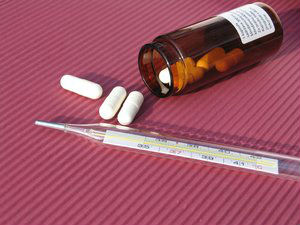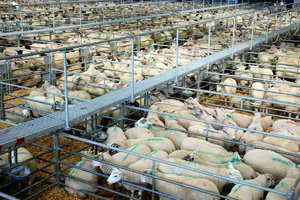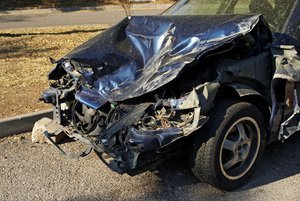We need to dive a bit further into the role irradiation plays when getting food transported and to the table. Let’s talk about why it is so common and whether it is fulfilling its promises to keep people safe.
If your child knowingly drank after a sick friend, and then said “hey, that is what antibiotics are for!” what would be your first reaction?

Let us look at it this way: you are in the passenger seat and the driver is texting, talking or otherwise preoccupied with anything but the road. The driver looks up at you and says, “hey, that’s what seatbelts and guard rails are for…” it is time to panic.

I just spent some time on the “Center for Disease Control & Prevention” (CDC) government website and I am pretty sure that I just read the above scenario (stated differently) on there. Except in this case, it is referring to raw meat and other foods. You see, who needs to worry about the quality of the meat, the condition of the CAFO’s or chicken houses, quality of the feed, or the care of the animal when you can just blast away all of the ickies with a mega dose ofir radiation?
Please read the statement for yourself:
Treating raw meat and poultry with irradiation at the slaughter plant could eliminate bacteria commonly found raw meat and raw poultry, such as E. coli O157:H7, Salmonella, and Campylobacter. These organisms currently cause millions of infections and thousands of hospitalizations in the United States every year. Raw meat irradiation could also eliminate Toxoplasma organisms, which can be responsible for severe eye and congenital infections. Irradiating prepared ready-to-eat meats like hot dogs and deli meats, could eliminate the risk of Listeria from such foods. Irradiation could also eliminate bacteria like Shigella and Salmonella from fresh produce. The potential benefit is also great for those dry foods that might be stored for long times and transported over great distances, such as spices and grains. Animal feeds are often contaminated with bacteria like Salmonella. Irradiation of animal feeds could prevent the spread of Salmonella and other pathogens to livestock through feeds. (CDC, 2005)
The above highlights are mine, and here is my reaction in the greater context of the situation:
1) Excuse me, but those are living animals! Forget what you can nuke their carcass with after the fact, they are alive. I agree that their purpose is to produce food. However, they need not be disregarded as dumb machines. Treating animals poorly is a precursor to seeing everything and everyone as utilitarian objects. Try starting with these questions: “What is the purpose of a cow/pig/chicken?” “What does the cow/pig/chicken need?” Instead of questions like this: “What can I get away with legally?” It may be legal, but it is immoral.

2)Joel Salatin is known for saying, “We are excellent at hitting the bull’s-eye on the wrong target.” Have you seen the average slaughter plant? Of course there is illness-inducing bacteria on the meat! It does not need to be that way, though. But is anyone asking how we can bring safe and ethical food production back to the local level?
3) If the just-heat-ready-to-eat-meat has Listeria, it is not exactly ready to eat, is it? When did grocery store shelves get so dangerous?
4) Transporting food over greater distances—sure, we can see some merit in that. Let us face it, I just cannot grow bananas in Northern Montana. But zapping food to make it last longer? If your food is no longer perishable, it is not food. If the bacteria that causes composting does not want touch something, then chances are I do not either. Put a pre-packaged yellowish tubular crème filled dessert cake on the counter and see when it begins to perish.

5) Animal feeds are often contaminated—really? And if we know this, why are we feeding it to them? Is the animal eating appropriate feed for that kind of animal? Most people might not know this—but cows were never supposed to have full-corn diets. They are supposed to eat grass in the field still growing or even properly hayed. Salmonella on prairie clover is quite unlikely.
They must have known I was reading this. The CDC continues:
Irradiation is not a short cut that means food hygiene efforts can be relaxed. Many steps need to be taken from farm to table to make sure that our food supply is clean and safe. Irradiation is a major step forward, but it does not replace other important efforts, including efforts to improve sanitation on the farm and in the food processing plant. For irradiation to be effective, the food that is to be irradiated already needs to be clean. The more initial contamination there is, the higher dose of irradiation it would take to eliminate possible pathogens, and the greater the change in the taste and quality of the food. The protection of irradiation will be overcome if the contamination levels are too high. (CDC, 2005)
Yes, I am a critic. Would I rather have the (current) alternative to irradiated food? Of course not! If you are only offering one alternative, that being to get sick or not, to poison my family or not…then yes I suppose I will take the zapped meat. But why accept just this one alternative? Perhaps it is time to loosen city ordinances to encourage “kitchen poultry” and “victory gardens” once again! Get to know your local farmer.
The CDC seems quite proud of sterile food production. No bacteria? That is like saying, “The good news is that we solved the termite problem. Bad news, we had to burn down the house to do it.” All bacteria is killed off in the food. Has anyone asked if this is healthy? Do you realize you have 3 trillion living beings within your own body? Not all bacteria is Salmonella, Listeria or E. Coli O157:H7. Bacteria are necessary for life and for your immune system.

We can keep building bigger, faster, higher capacity ambulances or we can ask the right questions to avoid generating more crash victims in the first place. More ϋbersterile food, or better food production methods?
I want to leave you with this thought—what are our alternatives? Be sure of this, we can actively speak a message with our purchasing power, with our voices, and with our backyard gardens. Let us get back to the basics of producing and processing our own foods as much as it is possible, and buying locally wherever possible. Let us aim for transparency when it comes to food production and smarter consumers to drive market forces.
Berger, M. E. (2003). Oak ridge institute for science and education. Retrieved from http://orise.orau.gov/reacts/guide/define.htm
Centers for disease control and prevention. (2005, October 11). Retrieved from http://www.cdc.gov/ncidod/dbmd/diseaseinfo/foodirradiation.htm#whichprevent
Centers for disease control and prevention. (2005, October 11). Retrieved from http://www.cdc.gov/ncidod/dbmd/diseaseinfo/foodirradiation.htm#replaceprevention
Organic Consumers Association. (2008, 08 25). History, background and status of labeling of irradiated foods. Retrieved from http://www.organicconsumers.org/Irrad/LabelingStatus.cfm
Organic Consumers Association. Induced radioactivity from electron-beam irradiation. Retrieved from http://www.organicconsumers.org/Irrad/InducedRadioactivity.cfm
Potter, J. (2010). Cooking for geeks: Real science, great hacks, and good food. O’Reilly Media, Inc.
Weston A. Price Foundation. (2003, December 8). Irradiated meat: A sneak attack on school lunches. Retrieved from http://www.westonaprice.org/modern-foods/irradiated-meat-school-lunches
Photo Credits:
Cocktail Franfurters by mOGTT4w
Antibiotics by nnLUem2
Empty Road by moNVEUQ
Sheep by mk4qyEe
Cow by mmqIkCS
Wrecked Car by mg21u9m
